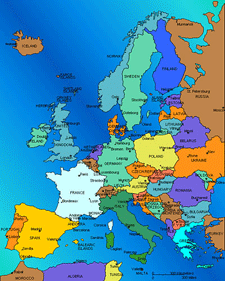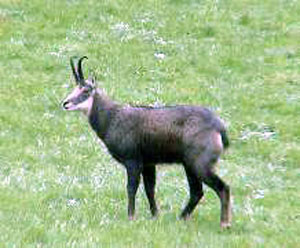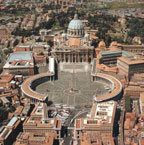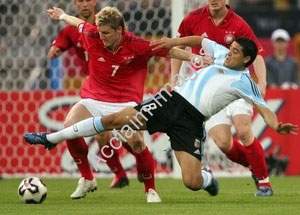

This Chartreuse chamois is an endangered species that lives in the mountains of Russia

This is Vatican City, the smallest city in the World

This fancy building is in Madrid, Spain.

Ther German football team working hard to win the game!
Number of Countries: 47 (But the boundaries and countries are constantly changing, so the number is debatable)
Largest Country: Russia
Smallest Country: The Vatican City (which is in the middle of Rome and is only 0.2 sq mile. It is the smallest country in the world!)
Largest City: Moscow, Russia
Highest Point: Mt. Elbrus in Russia (18, 481 ft high)
Longest River: Volga River in Russia (2,294 ft. long)
Economy: Europe gets a lot of their money from farming of vegetables, fruits and grains. They also have an abundant supply of chemicals and machinery. Europe has formed the "European Union" which shares one currency and makes trade between countries easy. The continent is divided into 2 for economy becasue the Western side is a lot richer than the Eastern side. Germany is the richest nation.
Climate: Even though Europe shares the same latitude as parts of the United States, the continent as a whole is warmer because of the gulf stream that blows warm air in that direction. Most of Europe is in the temperate climate zone, but the very most Northern part of Europe is subacrtic and polar. Much of Europe is marine west coast, which means it is cool and wet, but also has warmer summers. Europe also has a small amount of desert land and highlands. The Southern part of Europe touches the Mediterrean Sea and therefore has a Mediterrean climate, which is a mild climate.
Animals: Europe has many kinds of animals, including some that are endangered. Some of these include: The Spanish lynx, the Chartreuse chamois (which is like a goat), the European mink and the European bison. It also has the Beluga sturgeon that lives in the Mediterrean. Other animals include horses, moose, squirrels and weasels. The animals in Europe are much like the animals you would see in the United States.
Language: Every country in Europe has its own language, but many of the people speak several languages so that they can communicate with the countries around them. Some of the languages include: Portuguese, Spanish, French, Italian, German, English, modern Greek, several slavic languages (including Russian) and several scandinavian languages(including danish, finnish, norwegian and swedish).
Food: Every country in Europe also has its own menu. Italy is famous for their pastas, while France is famous for gourmets like croissants, snails, and cordon bleu. Some of the other foods of Europe are meats (like pork, beef, fish and chicken) and vegetables ( like carrots, turnips, spinach, peas, beans, cabbage and asparagus). The vegetables are often mixed into stews and soups. Europeans also enjoy bread of many kinds, desserts made of chocolate and sweets, as well as a variety of other foods.
People: The main religion of Europe is by far Roman Catholic. However, there is also a large number Orthodox churches, as well as some Protestant, Islam, Judaism and nonreligious people (such as agnostics and atheists).
European people love sports, but mostly football (which is known as soccer in the United States).
The traditions, artwork and cultures of Europe are influenced greatly by the Catholic religion, as well as the history of the nations. Many of the countries still house kings and queens in castles and beautiful houses. Many ruins of old buildings from centuries ago still stand for people to see and explore.